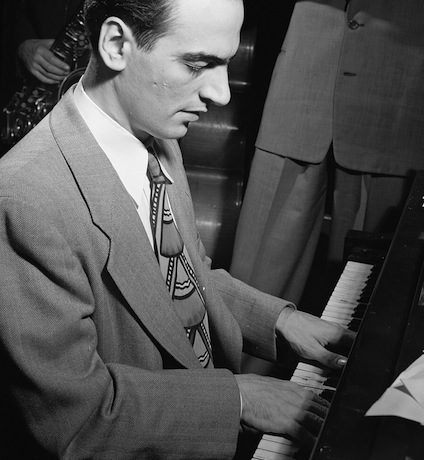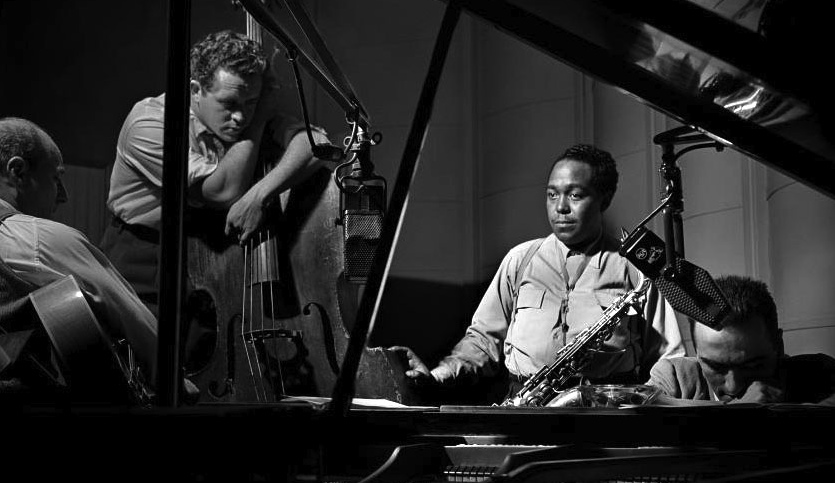 Leonard Joseph (Lennie) Tristano was born on March 19, 1919 in Chicago, Illinois and passed away on November 18, 1978 in New York City at the age of 59.
Leonard Joseph (Lennie) Tristano was born on March 19, 1919 in Chicago, Illinois and passed away on November 18, 1978 in New York City at the age of 59.
Lennie was born with weak sight, but became completely blind by age ten. Both of his parents emigrated from Italy, and his mother, a pianist and opera singer, taught him music. At a Chicago school for the blind, Tristano studied clarinet, cello, and saxophone as well as the piano. Chicago’s thriving jazz scene intrigued the teenaged Lennie, who often ventured by himself to the African-American clubs on the south side of town, where he first heard recordings of saxophonist Charlie Parker and others.
He graduated from Chicago’s American Conservatory of Music in 1943, and quickly established himself as a teacher and performer. There he met alto saxophonist Lee Konitz and Bill Russo, a trumpeter and arranger, both of whom became students and proponents of what would later be called ‘The Tristano School’ of jazz. He married singer Judy Moore on July 27th, 1945.
In 1946, the Tristanos moved to Freeport, Long Island. Lennie established a trio with a bassist and guitar player, and it was not long before he was performing with Charlie Parker and Dizzy Gillespie. The jazz critic Barry Ulanov promoted Tristano’s playing through his writings in Metronome magazine, which gave Lennie its Musician of the Year award in 1947.
Tristano’s approach to jazz was unusual in its day. Rooted in the vocabularies of swing and bebop, it strove for a harmonic complexity that owed as much to Stravinsky and other twentieth-century classical composers as it did to Ellington and Parker. His linear solos suggested the contrapuntal nature of Bach, while his harmonic and rhythmic ideas were consistent with bebop but took its conceptions even further.
In 1949 Tristano formed a sextet with Konitz, guitarist Billy Bauer, and tenor saxophonist Warne Marsh. Their recordings encapsulate Tristano’s signature style in their long flowing lines, odd rhythms, and musical counterpoint.
This group recorded two pieces, ‘Intuition,’and ‘Digression,’ that were both fully improvised, with no pre-laid musical structure. Ten years later, saxophonist Ornette Coleman adopted this approach and was heralded by many as the inventor of “free jazz,” but Tristano’s group did it first.
Tristano continued to perform and record in New York City, and set up his school in a loft at 317 East Thirty-Second Street. The topics of study included ear training, harmony and technique. Tristano encouraged students to sing along with the recorded jazz solos of master improvisers like Parker and tenor saxophonist Lester Young. Tristano’s systematic approach to teaching jazz influenced other schools, such as the Lenox School and the Berklee School of Music, whose curricula later spread to jazz schools throughout the world.
Tristano also built a recording studio in his loft, where he experimented with overdubbing on his compositions ‘Ju-Ju’ and ‘Pastime’. He recorded his trio with Peter Ind on bass and Roy Haynes on drums, and then overdubbed a second piano part. Some critics dismissed his experimentation, but many couldn’t tell it was two separate tracks from listening to it. He continued this practice with his 1953 recording ‘Descent into the Maelstrom’, which was not released until the 1970s.

In 1955, Tristano made some of his most important recordings. Ind and drummer Jeff Morton recorded several choruses of the chord changes to the standard ‘All Of Me,’ and Tristano overdubbed his piano solo. This track, ‘Line Up’, became his best-known performance.
Controversy roiled around these sessions, and some critics asserted Tristano altered the speed of the tape when he overdubbed the piano to make its sound stand out. Tristano never acknowledged using the technique, but the result is amazing to anyone’s ears.
In ‘Line Up,’ the Tristano approach is in full force. The linear motion is passionate but never out of control, and the melody snakes in and out of the harmony, resulting in odd over-the-bar phrasing and unusual harmonic super-impositions. He repeated the technique on ‘East Thirty-Second Street’ and ‘Turkish Mambo’ to similar effect, the latter a two-piano piece.
Tristano also liked to prerecord the rhythm section, so they would not become distracted by his unusual rhythmic and melodic ideas. The lack of interplay between the rhythm section and the soloist is one of the defining aspects of Tristano’s system.
He closed the studio in 1956, and moved his school to a house in Hollis, Queens, where he set up shop after his separation from Judy. His public performances dwindled off, but in 1958 he began what would become a long-term engagement at the Half Note. In 1961 he recorded a solo piano album, ‘The New Tristano’. It included a disclaimer that no overdubbing was used in the recording process. His harmonic and rhythmic approaches grew more advanced, as evidenced on ‘C minor Complex’ and the standard ‘You Don’t Know What Love Is’.
In 1964, Tristano reunited with Konitz and Marsh for an extended engagement at the Half Note. The next year he departed for a solo piano tour of Europe, which yielded several solo and trio recordings. He recorded with vocalist Betty Scott in 1965, 1971, and 1974, but stayed away from performing for the most part, concentrating on teaching. He gave private concerts at his home, mostly to his students and friends.
He suffered from emphysema, caused by a lifetime of smoking unfiltered cigarettes. He also developed chronic bronchitis, and these conditions lead to his death from a heart attack on November 18th, 1978.
Tristano has long been misunderstood as a jazz artist. Some people consider him an exponent of “cool jazz,” but he was dissimilar to many of the musicians of that movement. Critics call his music cold, intellectual, and unemotional, but there is a considerable passion in his playing. Tristano also distilled the elements of improvisation into a teachable system long before anyone else recognized the importance of jazz education.
Tristano’s prickly personality and his outspoken criticism of commercialism in music made him some enemies, but his contributions to jazz outshine any quirks of personality. Discipline and study remained his focus for himself and his students. His uncompromising passion for music never faltered. For, as he put it, “It would be useless for me to play something I don’t feel.“